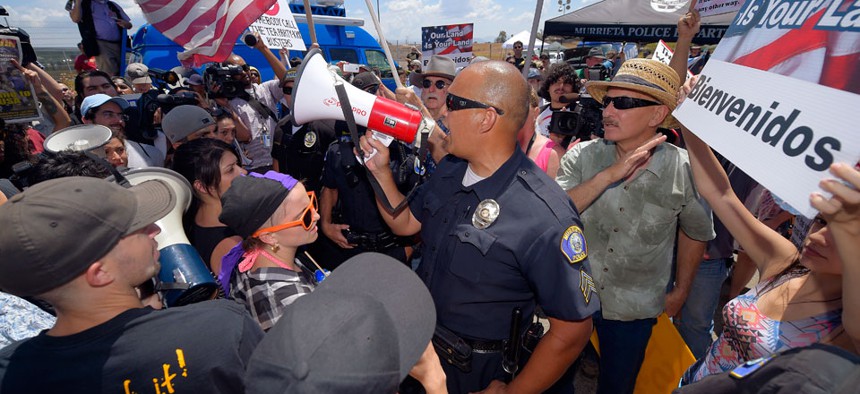Border Crisis Creates Record Case Backlog at Immigration Courts
Senate panel explores root causes of child migration but stresses deterrence.
As President Obama traveled to Texas to confront the continuing border crisis, a Justice Department official told senators that the number of cases pending before U.S. immigration review courts had swelled to a record high of 375,373.
The surge of some 57,000 unaccompanied children arriving at the southwestern border in recent months has prompted Justice to rush in 30 newly hired immigration judges and reset priorities, Juan Osuna, director of the Executive Office of Immigration Review, told the Senate Homeland Security and Governmental Affairs Committee on Wednesday. Court officials are focusing on four groups: unaccompanied children, adults with children in detention, adults with children who have been released from detention, and other individuals in detention. “We will do these cases quickly but will do them right.”
At a hearing focused on the reasons for the recent stream of children travelling through Mexico from Central America, often at the behest of criminal traffickers, senators grilled five agency witnesses on why the crisis wasn’t better anticipated. Most lawmakers agreed that the solution involves both treating children with compassion and sending a message of deterrence against more illegal arrivals.
“We have spent nearly a quarter trillion dollars securing our border since 2003,” said Chairman Tom Carper, D-Del. “At the same time, only a small fraction of this amount has been invested in addressing the root causes in Central America that are encouraging young children and their families to risk life and limb and make the long and dangerous trek to South Texas.”
Despite many successes in reducing illegal border crossings, Carper said, “the U.S. -- along with Mexico, Colombia, and others -- needs to do a better job of helping Central American countries help themselves.” That would involve “helping them create a more nurturing environment for job creation. Restore the rule of law. Lower energy costs. Improve workforce skills and access to capital,” he said. He expressed disappointment at a recent House decision not to take up comprehensive immigration reform as passed by the Senate.
But Sen. Tom Coburn, R-Okla., said, “We’ve known of this problem since January yet there was no mention of it in the president’s budget. The solution is to send them back.” Coburn repeatedly questioned a Health and Human Services Department official on whether his agency has a policy of not asking for the immigration status of U.S.-based adults who come forward to sponsor children and adults who arrive without documentation. “Don’t get me wrong, I’m all for safety of the children,” Coburn said, “but why don’t we ask?”
Mark Greenberg, acting assistant secretary for the Health and Human Services Department’s Administration for Children and Families, acknowledged such questions are not asked, saying that issue is better addressed by the Justice Department. The scale of the crisis, he said, “is straining our ability to place children in a timely fashion,” noting that his agency finds shelter through grant-funded nonprofits, many of them faith-based, and gives the children medical screenings and vaccines while finding an “appropriate sponsor in the least restrictive environment.” Over the past three years, the number of days for placing children has been reduced from 72 to 34, Greenberg added. The sponsors, mostly relatives, are “responsible for cooperating even if the children are later deported,” and must report any changes of addresses.
Craig Fugate, administrator of the Federal Emergency Management Agency, which is helping find shelter for the arrivals, said FEMA has not been able to find every child a bed within 24 hours and turn them over to HHS within 72 hours, the agency’s goal. “It’s a very fluid situation,” he said.
Customs and Border Protection recently added more than 250 Border Patrol agents to help manage the influx, said CBP Commissioner Gil Kerlikowske, but noted the agency’s facilities “were not designed to be occupied for a long period of time.” Kerlikowske said that while safety and economic opportunity in Mexico have improved notably, that’s not the case in Guatemala, El Salvador and Honduras.
But the Central American countries were praised as “good partners” by Thomas Winkowski, principal deputy assistant secretary at Immigration and Customs Enforcement. ICE has detailed 200 officers in the Rio Grande Valley, and in May alone made 163 arrests, followed by a surge in prosecutions, he said. The Homeland Security Department “does its best for the adults and children, but the crisis wears down the system,” he said. “The message must be one of deterrence."
The exodus from Central America has been fed by violence, poverty and weak public institutions, said Francisco Palmieri, the State Department’s deputy assistant secretary for the Caribbean and Central America, detailing the State Department’s use of short-term repatriation tools and long-term trade agreements. “It’s an environment many people want to abandon.”
Some of the tension surrounding the handling of the border crisis surfaced when Sen. John McCain, R-Ariz., blasted CBP for a recent memo he said would prevent lawmakers visiting temporary border detention facilities from bringing in a cellphone to take photos. “I want it fixed. You have overstepped your responsibilities,” McCain told Kerlikowske. “I want it revoked today, you understand?”
Kerlikowske said that for lawmakers, special arrangements would be made.
NEXT STORY: President Obama's Bizarre Trip to Denver




